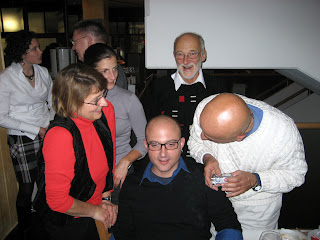Well, you can at least be funny about it.
Read Kriston's incisive yet silly review of Meat Market's Hogg and Pony show here.

Peter Ludwig: The man behind the collection.
Gerhard Richter's color charts--auto body paint on canvas. The window in Cologne Cathedral was modelled after these.

A wacky Bruce Naumann piece--is there any other kind?--dedicated to John Coltrane. The side facing the floor--and therefore not visible--is mirror-polished.
 Nope. Try Henrik Schrat. Who knew that Walker didn't have a patent on silhouettes-as-art?
Nope. Try Henrik Schrat. Who knew that Walker didn't have a patent on silhouettes-as-art?
The piece on the left, however, really is Jenny Holzer.
Jasper the friendly ghost.


Mona Hatoum. A light bulb in the middle of the room slowly ascends and descends, causing the gridded shadows to creep up and down the walls around you.
Can't remember this artist's name...but there was a whole series of knitted clothes here, each for a different bird species.
Not pictured: Jeff Koons's penis.

 Oh, it's that guy again.
Oh, it's that guy again.
Andreas Magdanz and Stephan Morsch examine Evan Reed's Arlington House.

From left to right: Artists Maria Karametou, Mona Sfeir, and Amy Glengary-Yang.

In my last post, I erroneously referred to Mona's piece as Flying Carpet--that was the title on her loan form, but neither of us can figure out how it got there. Anyway, the actual title is Return. Now you know.
Blurry shot of gallery-goers enjoying the work in Hans Niehus's space.

Untitled light sculpture by Tobias Danke.

Caroline Danforth, undoubtedly conversing in fluent German with the invaluable Holger Hermannsen.

Closeup installation view of Caroline's 5" X 5" aerial landscape paintings.

Harald and Holger toast a job well done.

From left to right: AAC Executive Director Claire Huschle; LF Director Harald Kunde; Stephan Morsch and his family; the top of Chawky Frenn's shiny bald head.






Maria Karametou.


Amy Yang's Phosphorflock. Yes, those are my disembodied legs in the mirrored pedestal--topped off by a glowing sea urchin.

Amy Yang, her sister, and the amazing, ever-patient Holger.

Heinz and his crew: Very professional; very fast.

The house of Dr. Kosters.

German artists Hans Niehus, Andreas Magdanz, and Stephan Morsch.

Director Harald Kunde with Hans Niehus.

Evan and Mona.
 Like previous Kahn and Selesnick projects, the objects and images in this show construct an alternative history based loosely on real events--in this case, an iceberg running aground in 1923 off of the coast of Lubeck, Germany. The two artists use this as a jumping of point to examine contemporary crises--global warming, end-of-times rhetoric, inflated currencies.
Like previous Kahn and Selesnick projects, the objects and images in this show construct an alternative history based loosely on real events--in this case, an iceberg running aground in 1923 off of the coast of Lubeck, Germany. The two artists use this as a jumping of point to examine contemporary crises--global warming, end-of-times rhetoric, inflated currencies. Eisbergfreistad doesn't share that disparity. In fact, as handsome as these elongated color prints are, they seem a bit familiar. Sure, there are some arresting images: The card players in Card Game sit in the shadows of a city made from melting ice; they fritter away their presumably now-worthless spoils--hoarded during fears of an impending apocalypse. They all wear overcoats and animal masks, vaguely recalling the monstrous appearance of generals and businessmen in drawings by German artist George Grosz--say, Die Stimme des Volkes, die Stimme Gottes (1920), from the NGA's Dada exhibition.
Eisbergfreistad doesn't share that disparity. In fact, as handsome as these elongated color prints are, they seem a bit familiar. Sure, there are some arresting images: The card players in Card Game sit in the shadows of a city made from melting ice; they fritter away their presumably now-worthless spoils--hoarded during fears of an impending apocalypse. They all wear overcoats and animal masks, vaguely recalling the monstrous appearance of generals and businessmen in drawings by German artist George Grosz--say, Die Stimme des Volkes, die Stimme Gottes (1920), from the NGA's Dada exhibition.